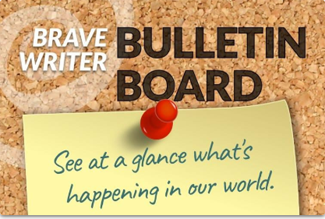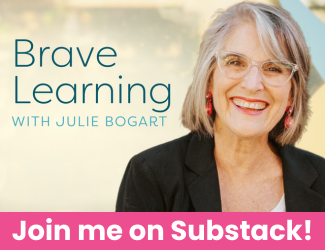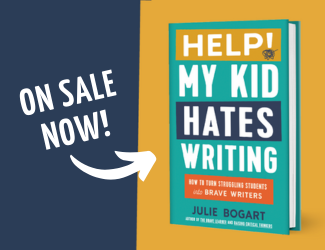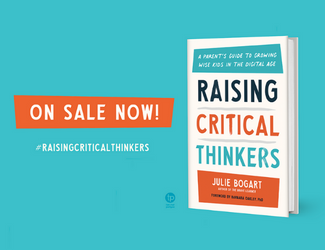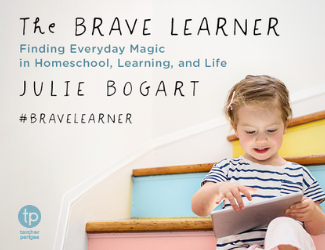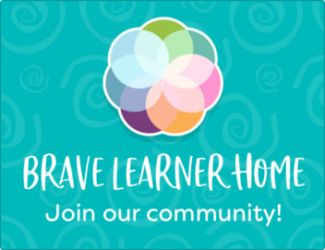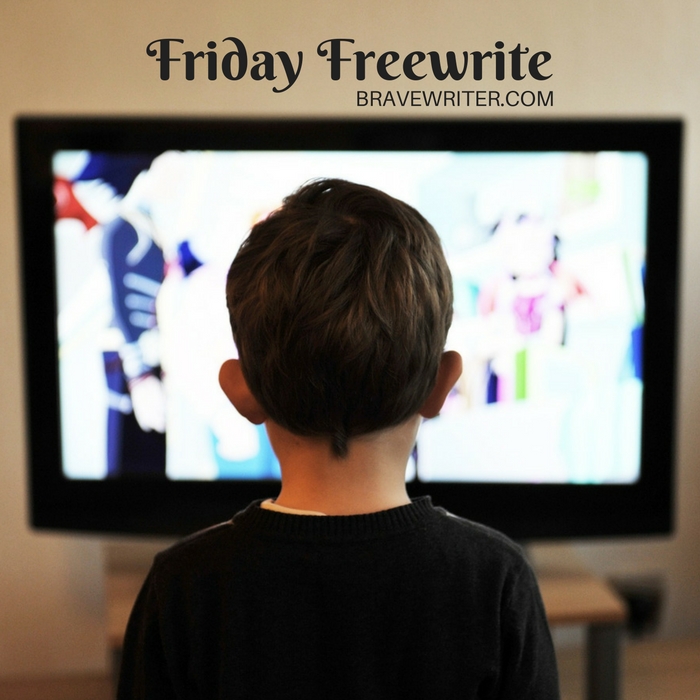
What’s your favorite TV show? Compare the episode you like best to the episode you like least.
New to freewriting? Check out our online guide.

What’s your favorite TV show? Compare the episode you like best to the episode you like least.
New to freewriting? Check out our online guide.
Posted in Friday Freewrite | Comments Off on Friday Freewrite: Favorite TV Show
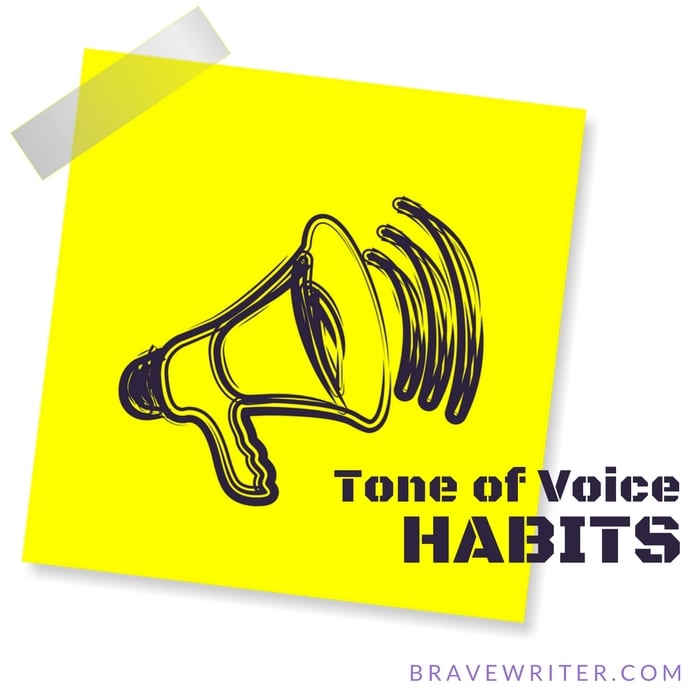
Melissa Wiley was asked in the BraveSchoolers Facebook group about what to do when kids have a snotty-tone or interrupt. Here is her brilliant reply (shared with permission and emphasis is ours).
I think tone is a really fun thing to work on because it gives the kids an opportunity to ham it up a bit. And in truth, we are all prone to lapses in tone now and then, me included. A friend of mine has a great story about having to listen to a message she had left on her son’s voice mail. She was shocked by how brusque and irritable she sounded. I have never forgotten that story!! I bet there are loads of times I would wince to hear a replay of words that came out of my mouth.
I start working on good tone habits by making it 100% a game at first. They don’t know I have an ulterior motive. 🙂 I pick a good moment—and I make sure it’s going to be a good WEEK for practicing. Whenever I’m building a habit, I look at the weeks ahead to think about what opportunities we’ll have for practicing it.
So: when the time is right (we are hanging out together, no high pressure/time constraints/overtired kids), I’ll say:
“Let’s play a game. Pretend you want a drink of juice and ask me in your rudest, snottiest tone.”
Kids think this is hilarious and tend to really get into the acting job. Then I’ll ask them to do it in a whiny tone. And I’ll praise their performance: “Wow!! That is impressively whiny!!” —stuff like that. Then while we’re all laughing, I’ll ask them to ask again in their most beeyootiful manners—or in a sweet tone—or whatever. And again, they seem to enjoy that performance. So that first day, we’re just playing an acting game, really. Sad tone, mad tone, scared tone—we’ll run through a bunch.
After that I’ll watch for opportunities to practice in real life. Usually someone will whine or snap later that day or the next and then I’ll say—in a very casual, no-big-deal tone myself—”hmm, could you try that again in a different tone?” I’m not stern, I’m not scolding, I’m being lighthearted and nudging them toward a different way of framing the question. I try to keep that same game-like spirit about it. In that moment, a really grumpy kid might not want to play the game, in which case I won’t push it. It’s still early stages.
At some point that first week, we’ll (again when the stakes are low and everyone is mellow) have a conversation about tone. If it doesn’t come up organically, I might work it into a read-aloud—like, I’ll read a bit of dialogue and then say, “Wait, I don’t think that sounded right. Should it have a more grumpy tone?” or some such. And this will spark a discussion about what a difference tone makes. I remember one time we got into a kind of group contest to see how many different ways we could say the word “No” —how many meanings we could convey via tone.
So what I’m trying to convey here is that once I have identified a habit I’d like to build, I look hard at natural ways to ‘practice’ it in everyday life, in a light, fun way. And after we’ve had time for playfully practicing it (even if the kids are not aware that’s what we’re doing), I’ll let them know—again, in as organic a moment as possible, when something pops up that makes this relevant—that we’re all going to work on (in this case) using really kind tones with each other. I’ll encourage the kids to try to “catch” me using an impatient or crabby tone. THEY LOVE THIS MOST OF ALL. And if someone is snappish or whiny or snotty or whatever, I’ll ask, as I said above—not reprovingly, just cheerful and matter of fact— “Could you try that again in a different tone?” This stage of habit-building typically lasts 2-3 weeks.
After that, I’ll let them know that I expect them to use a pleasant tone the first time, when asking for a drink or whatever. And I’ll continue to remind as needed. If it seems like the habit isn’t sticking, we’ll go back to the game and keep practicing for a few days. Or if, say, a year passes and I notice people are starting to be short with each other, I’ll reintroduce the game and the expectation. (In our family we call this “boot camp” for reasons dating back about 15 years.)
In the moment—when an annoying tone is aimed at you in the ordinary course of the day—is NOT the time to work on building this habit. In the moment, we’re reacting, one way or another. Don’t beat yourself up for having genuine (negative) reactions in the moment. We all do. That’s how you know the behavior is something that could be improved by working together on a new habit.
Instead of thinking of it as something to remember in the moment, you can plan it, just as you would plan any other activity. It’s a little like potty training or copywork. You set aside a time in your own mind for gently easing into this new thing. Because that’s what it is: a new accomplishment you’re helping the kids master.
Controlling our tone of voice in the emotional moment is hard and takes practice. Years of practice, for most of us! And even though I make a joke with my kids about using a “snotty” tone when we’re playing the game, I’m not thinking of it (snotty tone) as a form of misbehavior. It’s just a placeholder for a more appealing habit that hasn’t been learned yet.
As for the interrupting—I use the same 6 week, gamify-it-first process. I teach them to put a hand on my wrist if they want to say something while others are talking, and I put my hand over theirs to show I’m aware they are waiting to speak. And then I try really hard to give them the chance to talk ASAP! Often I have realized a kid has been holding my wrist for five minutes and I look down to see a big grin because Huck knows he caught ME this time—I’m the one who needs boot camp for that habit. 🙂
I think the important thing is the overall attitude about habit building. I love that I can approach things from a positive, proactive perspective instead of being critical and reactive. What GOOD habits would I like to see in place of things that irritate me (or others)? How can we build those good habits TOGETHER in a spirit of fun?
Posted in Homeschool Advice | Comments Off on Working on Tone of Voice with Kids
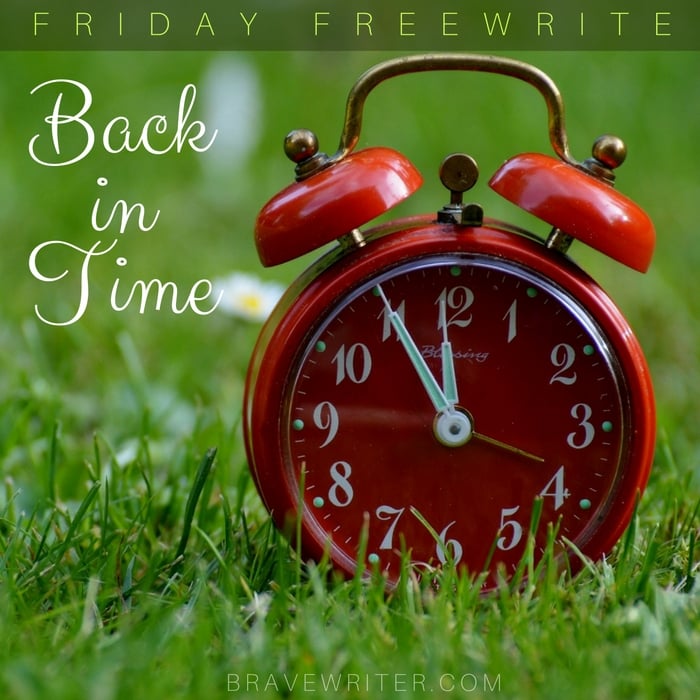
This will test your memory! What were you doing one minute ago, one hour ago, one day ago, one week ago, one month ago, and one year ago? Write it!
New to freewriting? Check out our online guide.
Posted in Friday Freewrite | Comments Off on Friday Freewrite: Back in Time
Get to know Brave Writer and find out how the program actually works!
You’re in for a paradigm-shifting experience. Hold onto your hats! I show you the products and help you navigate the site!
Also, forgive the few upside down shots in the video. When we uploaded our Scopes to YouTube, they lost the ability to right themselves whenever I flipped the camera.
Posted in BW products, Periscopes | Comments Off on A Guided Tour of Brave Writer
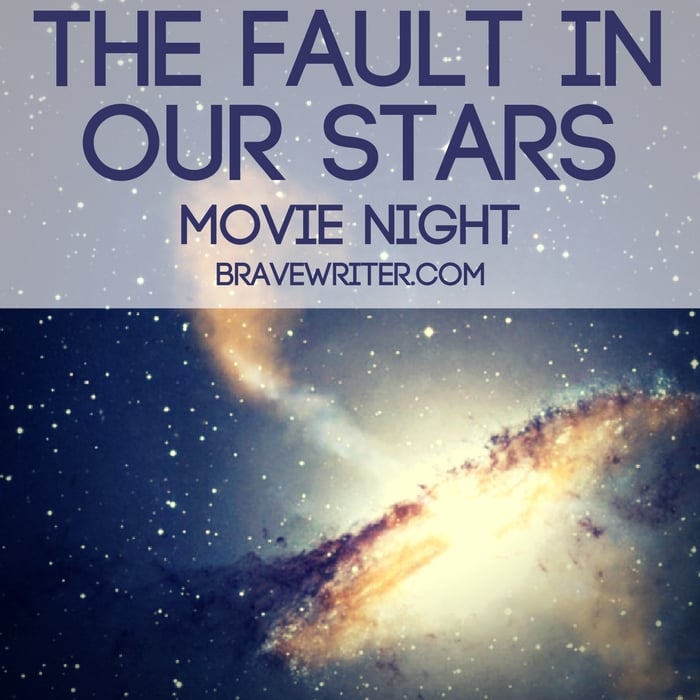
Hazel Grace Lancaster is seventeen and has cancer. Her life is hardly fantastic, but she’s coping. Everything changes however when she goes to a cancer support group and meets Augustus Waters, a fellow sufferer, whom she forms a connection with. They bond over Hazel’s favorite novel, An Imperial Affliction, and grow closer through their mutual wisdom beyond their years and their fears for the future.
[This post contains Amazon affiliate links. When you click on those links to make purchases,
Brave Writer receives compensation at no extra cost to you. Thank you!]
Hazel doesn’t want to fall in love with Gus—she knows that if she does, she’ll only break his heart when she dies. However, when the two decide to make a trip to Amsterdam to seek out the mysterious author of An Imperial Affliction, they’ll find out that certain things are just meant to be.
The Fault in Our Stars is a difficult film to watch, but it’s also considered by many an exquisite piece of film-making. Consider it for the next movie night with your older children and teens.
Please note: this PG-13 film contains mature themes. In order to evaluate whether or not it’s appropriate for your family, we recommend watching it first and/or using the Kids-in-Mind website.
Dutch Recipes – Try these delicious Dutch dishes.
Faulty math in the Fault in our Stars? – “Some infinities are bigger than other infinities” but maybe not in the way you might think.
Shakespeare Inspired Novel Titles – Want more Shakespearean titles? Here, have a bunch!
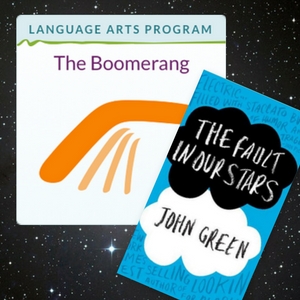 Learn language arts naturally with the Fault in Our Stars Boomerang!
Learn language arts naturally with the Fault in Our Stars Boomerang!
The Boomerang is a monthly digital downloadable product that features copywork and dictation passages from a specific read aloud novel. It is geared toward 8th to 10th graders (ages 12—advanced, 13-15) and is the indispensable tool for Brave Writer parents who want to teach language arts in a natural, literature-bathed context.
Posted in Wednesday Movies | Comments Off on Movie Night: The Fault in Our Stars

I’m a homeschooling alum -17 years, five kids. Now I run Brave Writer, the online writing and language arts program for families. More >>
IMPORTANT: Please read our Privacy Policy.






